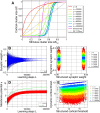The self-organized learning of noisy environmental stimuli requires distinct phases of plasticity
- PMID: 32166207
- PMCID: PMC7055647
- DOI: 10.1162/netn_a_00118
The self-organized learning of noisy environmental stimuli requires distinct phases of plasticity
Abstract
Along sensory pathways, representations of environmental stimuli become increasingly sparse and expanded. If additionally the feed-forward synaptic weights are structured according to the inherent organization of stimuli, the increase in sparseness and expansion leads to a reduction of sensory noise. However, it is unknown how the synapses in the brain form the required structure, especially given the omnipresent noise of environmental stimuli. Here, we employ a combination of synaptic plasticity and intrinsic plasticity-adapting the excitability of each neuron individually-and present stimuli with an inherent organization to a feed-forward network. We observe that intrinsic plasticity maintains the sparseness of the neural code and thereby allows synaptic plasticity to learn the organization of stimuli in low-noise environments. Nevertheless, even high levels of noise can be handled after a subsequent phase of readaptation of the neuronal excitabilities by intrinsic plasticity. Interestingly, during this phase the synaptic structure has to be maintained. These results demonstrate that learning and recalling in the presence of noise requires the coordinated interplay between plasticity mechanisms adapting different properties of the neuronal circuit.
Keywords: Intrinsic plasticity; Learning; Noise-robustness; Sensory pathways; Synaptic plasticity.
© 2019 Massachusetts Institute of Technology.
Figures







Similar articles
-
Sparseness and expansion in sensory representations.Neuron. 2014 Sep 3;83(5):1213-26. doi: 10.1016/j.neuron.2014.07.035. Epub 2014 Aug 21. Neuron. 2014. PMID: 25155954
-
Fast Learning with Weak Synaptic Plasticity.J Neurosci. 2015 Sep 30;35(39):13351-62. doi: 10.1523/JNEUROSCI.0607-15.2015. J Neurosci. 2015. PMID: 26424883 Free PMC article.
-
Human brain plasticity: evidence from sensory deprivation and altered language experience.Prog Brain Res. 2002;138:177-88. doi: 10.1016/S0079-6123(02)38078-6. Prog Brain Res. 2002. PMID: 12432770 Review.
-
Learning structure of sensory inputs with synaptic plasticity leads to interference.Front Comput Neurosci. 2015 Aug 5;9:103. doi: 10.3389/fncom.2015.00103. eCollection 2015. Front Comput Neurosci. 2015. PMID: 26300769 Free PMC article.
-
[Acquiring new information in a neuronal network: from Hebb's concept to homeostatic plasticity].J Soc Biol. 2008;202(2):143-60. doi: 10.1051/jbio:2008018. Epub 2008 Jun 13. J Soc Biol. 2008. PMID: 18547512 Review. French.
Cited by
-
The Interplay of Synaptic Plasticity and Scaling Enables Self-Organized Formation and Allocation of Multiple Memory Representations.Front Neural Circuits. 2020 Oct 7;14:541728. doi: 10.3389/fncir.2020.541728. eCollection 2020. Front Neural Circuits. 2020. PMID: 33117130 Free PMC article.
References
-
- Albus J. S. (1971). A theory of cerebellar function. Mathematical Biosciences, 10(1), 25–61. 10.1016/0025-5564(71)90051-4 - DOI
LinkOut - more resources
Full Text Sources
